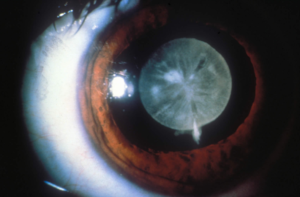Pretty much everyone has heard of cataracts; either through family, friends or personal experiences, but how much do you know about cataracts? While optometrist may not know precisely what causes cataracts, we can shine the light on key factors that cause changes in our eyes which lead to this ocular condition.
Cataracts by definition are a clouding of the lens in the eye which creates a decrease in vision. As the clouding worsens patients begin to experience symptoms like blurred, foggy, double or ghosting vision. In some cases color vision can also be altered, as well as, sunlight and headlights causing glare problems. Patients will also admit that adjusting to different lighting becomes more difficult (e.g. coming inside from the bright outdoors or going from a dimly lit place to the bright outdoors takes longer to adapt to). 
We also know that chemical changes in the lens cause it to get cloudy and advance the stage/severity of cataracts. These chemical changes may be the result of the aging process, heredity, exposure to ultra-violet light, an eye injury, medication (e.g. steroids), disease or a combination of all these factors. While cataracts often appear after the age of fifty, there have been cases found at younger ages, even in babies.
When it comes to the rate of cataract development, well that’s another mystery. This development rate varies from patient to patient. In some instances they can be slow, taking years to disrupt the patient’s visual acuities; while others develop more rapidly within weeks or months from diagnosis. As cataracts develop we often see impairment in the eye’s ability to focus, necessitating a change in glasses or contact lenses to see clearer. Eventually the cloudiness becomes so severe that even changing glasses or contacts will not improve the daily activities. At this point, your eye care professional will need to discuss the need for surgery.
So there you have it, the cloudy truth about cataracts and how they affect your vision.
